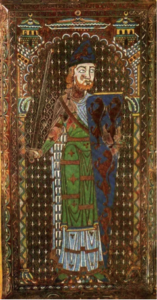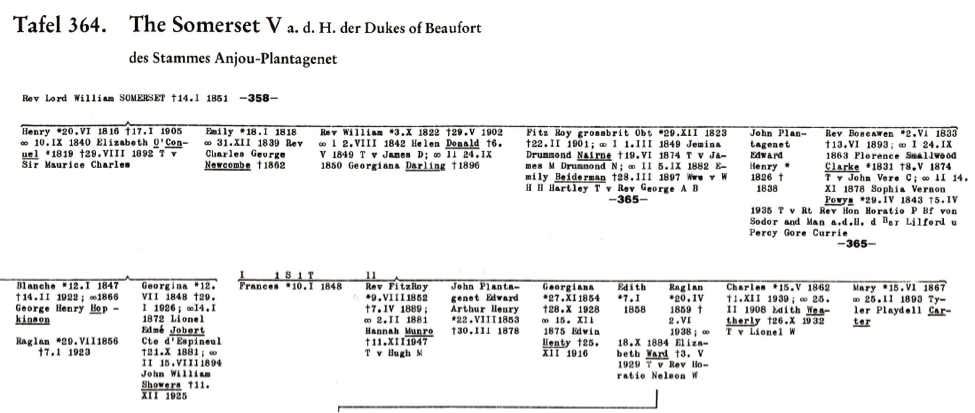Following up on my prior post on retroactive suffixes, I’ll now discuss the other practice of retroactive surnames. This frequently occurs in publications relating to royalty in the medieval period, the best example being the “surname” Plantagenet. Geoffrey V, Count of Anjou (1113-1151), had Plantagenet as an epithet or nickname, but this was not used as a surname by himself or his children. His son Henry II became King of England in 1154 as the first Angevin monarch, as Geoffrey was a member of the House of Anjou. Three centuries later in 1448, Geoffrey’s great-great-great-great-great-great-great-grandson Richard, 3rd Duke of York (1411-1460), adopted “Plantagenet” as his family name. The surname Plantagenet was even used by two illegitimate children of Richard’s son King Edward IV. However, Richard’s male line soon died out in the aftermath of the Tudor conquest of England in 1485. The last living legitimate male born with the surname Plantagenet was Richard’s grandson, Edward Plantagenet, Earl of Warwick, who was beheaded in 1499, and King Edward IV’s illegitimate son Arthur Plantagenet, Viscount Lisle, died in 1542.
However, this surname (which was used for less than one hundred years) would have lasting effects in later genealogies and naming customs. One pattern has been to retroactively apply the surname “Plantagenet” to any male-line descendant of Geoffrey V, Count of Anjou, whether legitimate or illegitimate, when no other dominant surname or demonym was used (such as the sons of King Edward III, who were known by their birthplaces, i.e. Lionel of Antwerp, John of Gaunt, etc.). I’ve seen this retroactive convention as early as the first years of the seventeenth century, in the first scene of William Shakespeare’s play The Life and Death of King John, referring to the king’s nephew Arthur, Duke of Brittany as “Arthur Plantagenet.” This is largely the pattern used in Gary Boyd Roberts’s The Royal Descents of 900 Immigrants. Using this as a guide for some charts in presentations at our annual dinners, I will sometimes, out of habit, design a chart that goes through one of King Edward I’s daughters – either Joan or Elizabeth (who are ancestors of several colonial American immigrants) – and apply the surname Plantagenet. Then Scott Steward will change it to “of England”!
"It is interesting to note that through the family of Cornwall, uninterrupted male descent from the Plantagenets, with but this one illegitimacy, still exists."
During the 1960s, a two-part article by Walter Lee Sheppard Jr. was published in The New England Historical and Genealogical Register entitled “Royal Bye-Blows,” which summarized known (and claimed) illegitimate children of the English monarchs from William the Conqueror to Queen Anne.[1] After listing the illegitimate children of Richard, Earl of Cornwall (a younger son of King John), Sheppard noted “It is interesting to note that through the family of Cornwall, uninterrupted male descent from the Plantagenets, with but this one illegitimacy, still exists. Through the Somerset family…[,] descendants of Charles Somerset, Earl of Worcester, and his descendants, the Dukes of Beaufort, there is also uninterrupted male descent from the Plantagenets, but through two or more illegitimacies...”
Obviously Sheppard is using the surname Plantagenet in the modern sense, but this reminded me of a past post I wrote on the Y-DNA results of the remains of King Richard III, and how they were not a match to male-line descendants of the 5th Duke of Beaufort in the Somerset family. What I had not mentioned was that both the House of Cornwall and the Somerset family were well aware of their (on paper) ancestral “Plantagenet” descent. The Cornwalls owned a mansion in Tenbury styled “Plantagenet House,” and by the nineteenth century, the Somerset family was using Plantagenet as a middle name, as shown on a portion of this chart from Europäische Stammtafeln:
Whether used by genealogists for organizational purposes or out of a sense of “dynastic pride,” retroactive surnames like Plantagenet can certainly have an impact even today!
Note
[1] Walter Lee Sheppard, Jr., “Royal Bye-Blows – The Illegitimate Children of the English Kings from William I to Edward III,” Register 119 [1965]: 94-102, “… [Part] II …. Edward III to Queen Anne,” 121 [1967]: 185-91. Note that some people listed in these articles have since been disproven as children of a monarch. These articles were also used as a guide for the Descendants of the Illegitimate Sons and Daughters of the Kings of Britain (the “Royal Bastards”), founded in 1950, for which Sheppard was the first Secretary-Treasurer (and an organization I joined a few months ago). I would also like to thank Nathaniel Lane Taylor, editor of The American Genealogist and current Herald-Genealogist of the Royal Bastards, for reviewing this post.
Share this:
About Christopher C. Child
Chris Child has worked for various departments at NEHGS since 1997 and became a full-time employee in July 2003. He has been a member of NEHGS since the age of eleven. He has written several articles in American Ancestors, The New England Historical and Genealogical Register, and The Mayflower Descendant. He is the co-editor of The Ancestry of Catherine Middleton (NEHGS, 2011), co-author of The Descendants of Judge John Lowell of Newburyport, Massachusetts (Newbury Street Press, 2011) and Ancestors and Descendants of George Rufus and Alice Nelson Pratt (Newbury Street Press, 2013), and author of The Nelson Family of Rowley, Massachusetts (Newbury Street Press, 2014). Chris holds a B.A. in history from Drew University in Madison, New Jersey.View all posts by Christopher C. Child →

